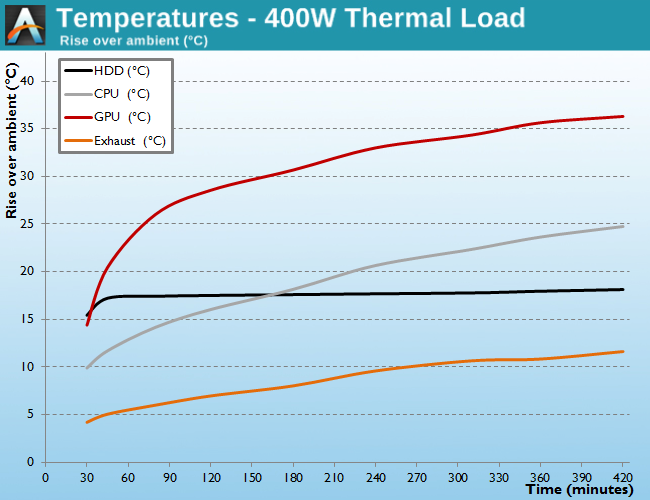Corsair Obsidian 450D Case Review
by E. Fylladitakis on April 4, 2014 6:00 AM EST- Posted in
- Cases/Cooling/PSUs
- Corsair
- mid-tower
- Case
Test Setup
Professional testing requires the emulation of real-world situations but with repeatable results; thus, a perfectly controllable test setup and environment are required, especially for comparable results. Testing the thermal performance of any case with a typical real-world setup technically limits the comparability of the results to this setup alone, as an active system interacts with its environment and the change of a single component alters (albeit in small ways) myriads of variables. In order to eliminate such factors, we developed synthetic loads that emulate the thermal output of real systems that are passive, steady and quantifiable.
Our thermal testing now displays the thermal capabilities of the case alone, as if it must deal with the entire thermal load by itself, regardless of the system that might be installed inside it. Laboratory data loggers are used to monitor the PT100 sensors and control the safety relays, which are fully accessible via our custom software. Three such loads have been developed, and today we'll be using the ATX load.
The ATX version simulates a 200W CPU, 50W VRM, 30W RAM and 4 × 120W GFX card thermal load; additionally, three 3.5" HDD dummy loads are also present that each convert 30W of electrical power to thermal, bringing the total thermal load of the ATX test setup up to 850W. As such, the thermal load is immense and only the best of cases will be able to handle it for more than a few minutes. We also test with a thermal load of 400W, with all of the aforementioned components except the HDD drives at about 42% power, which is more suitable for the majority of cases.
Thermal testing is performed with all of the case's stock fan operating at maximum speed. Noise testing is performed with a background noise level of 30.4dB(A).
Results and Discussion
Due to the excessive ventilation and good stock cooling fans, the thermal performance of the Corsair Obsidian 450D is great for a mid-tower case. As there is virtually no way for the warm air to get trapped inside the Obsidian 450D, even the stock cooling options are sufficient to handle a massive thermal load. It handled the massive 850W load induced by our test system for over one and a half hours and displayed great thermal inertia when the load was reduced down to 400Watts. Judging by the performance figures of our testing, the thermal performance of the Obsidian 450D could give a lot larger and more expensive cases a run for their money.
The excellent thermal performance of the Obsidian 450D however is not without side effects. With the exception of the side panels, every other panel of the case is perforated and virtually no measures have been taken to reduce the noise output; even the front panel cover is punched full of holes. As a result, the Obsidian 450D makes virtually no attempt to reduce noise levels in terms of the casing. Fortunately, Corsair has installed very good stock cooling fans that generate very little noise even at their maximum speed. If the voltage of the fans is reduced to 7V or below, the most sensitive ears will be able to catch only a very slight aerodynamic humming noise from a short distance. If low noise operation is a concern, with careful planning it is easy to have a very low noise system set up inside the Obsidian 450D, but this case has not really been designed with that in mind.













36 Comments
View All Comments
Larry Endomorph - Friday, April 4, 2014 - link
Nice review. But, ...Your line charts are useless for color blind people.
Add tick marks to the lines. Something like this:
http://www.excel-easy.com/examples/images/line-cha...
E.Fyll - Friday, April 4, 2014 - link
I am sorry, I cannot simply do that, the data points are far too many. I will see if I can do something about it though.Larry Endomorph - Friday, April 4, 2014 - link
Thanks.Another idea:
http://amplusmarketing.com/sites/all/themes/amplus...
The_Assimilator - Friday, April 4, 2014 - link
Sooo... it's basically a Fractal Design Arc Midi R2, with fewer hard drive trays and hard drive cage positioning options, more plastic, and a slightly different look... and the Arc Midi is $20 cheaper.Yeah, no.
The_Assimilator - Friday, April 4, 2014 - link
Oh... and the Arc Midi comes with a built-in 3-channel fan controller. Try harder, Corsair.NeatOman - Friday, April 4, 2014 - link
I like my Lian-Li PC-7HXW better, i picked it up for $90. I just inverted the side window.. it was very ugly on the outside IMOEnzoFX - Friday, April 4, 2014 - link
The proportion to cases that are useless to me, to ones I would consider for future builds here at Anandtech is retarded. How about more ITX cases?Razorbak86 - Friday, April 4, 2014 - link
"Retarded"? Seriously? Are you 12 years old?The_Assimilator - Saturday, April 5, 2014 - link
How about: no.FriendlyUser - Saturday, April 5, 2014 - link
You live in a closet and can't afford the space for a midi tower?